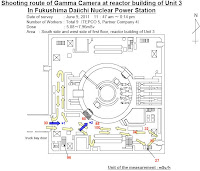Kyodo News Japanese reports that the Marine Biological Laboratory (MBL) in Woods Hole, Massachusetts has started the survey off the coast of Fukushima to study the extent of radiation contamination in the marine environment. No information in the Kyodo article as to since when the MBL has been doing the survey.
The MBL is the oldest independent marine laboratory in the US, and one of the most prominent; to date, 54 MBL-affiliated scientists have been awarded the Nobel Prize, among many other honors received by the laboratory’s researchers, according to Wikipedia.
The MBL, according to Arnie Gundersen during the interview with Chris Martenson the other day, has said that "the ocean has ten times more radiation from Fukushima than the Black Sea did from Chernobyl."
True to form, the Japanese government didn't bother to announce (it still doesn't) that it has approved the request for the survey, because, according to Kyodo News, "It's done by a US institution not by a Japanese one."
From Kyodo News Japanese (6/11/2011):
福島第1原発事故を受け、米ウッズホール海洋学研究所の専門家 チームが、福島県などの沖合で海洋調査を始めたことが11日、分かった。海水や海洋生物を採取し、原発から放出された放射性物質が生態系に及ぼす影響を評 価する。日本政府は米国からの調査申請を許可したが、米国による調査であることを理由に事実を公表していない。
It was discovered on June 11 that a team of experts from the Marine Biological Laboratory in Woods Hole, Massachusetts in the US has started the survey off the coast of Fukushima Prefecture. The team will collect sea water samples and marine lives, and evaluate the effect on the marine ecosystem from the radioactive materials released from Fukushima I Nuclear Power Plant. The Japanese government approved the request for the survey, but it continues to withhold the details because it is a survey by an American institution.
文部科学省などの調査では、広範囲で海水や海底の土から放射性物質が検出され、魚介類からも放射性物質が確認されている。ただ、こうした調査結果を取りまとめ、生態系への影響を評価する作業には着手しておらず、米国主導の調査が先行する形となりそうだ。
According to the surveys by the Ministry of Education and Science and other agencies and institutions, radioactive materials have been found in sea water and the ocean soil in wide areas. They've been found in fish and shellfish. However, the Japanese government hasn't started consolidating the survey data and evaluate the effect of radiation on the total marine ecosystem, letting the US lead the way.
Well, the Japanese government hasn't started it, because it doesn't want to. At least not right now. In fact, the government agency in charge of fisheries doesn't believe in "bioconcentration" or "bioaccumulation", and I don't expect them to do anything to disturb their belief system.
I hope the MBL will release the survey results for the benefit of the rest of us.



















 Tokyo Time
Tokyo Time
![[Most Recent Quotes from www.kitco.com]](http://www.kitconet.com/charts/metals/gold/t24_au_en_usoz_2.gif)

